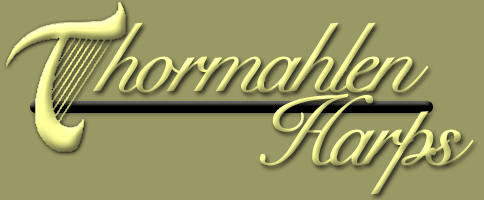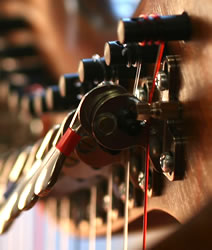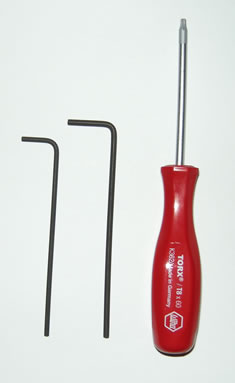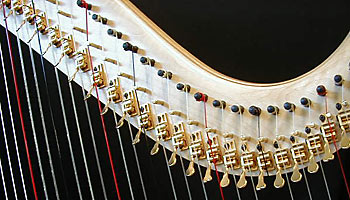|
| Levers Camac, Loveland, and Truitts This page is about letting you know about the 3 main types of levers that are available for lever harps. Thormahlen Harps are fitted with Camac Levers as the standard option. We highly recommend the Camac Levers above all others. To us they have the clearest tone and are the easiest to regulate. If you are used to one kind of lever and are reluctant to get Camacs, I suggest you think of it like driving a new car. There are always adjustment to be made, like finding the wind shield wiper switch or the light switch. The steering wheel feels different at first, but before you know it, you're totally used to it and what you had before feels strange. So let me suggest that this is what will happen with these levers. You will love them!
Camac levers are a silver color made totally from metal.
The C and F lever handles are colored with red and blue bands to make
lever identification easy. These levers give accurate half steps without
changing the tone of the strings. The tone difference of the levered
string is virtually undetectable to one that is not levered. They have
a smooth and quiet action with a This lever regulating tool kit, which comes complete with instructions is available for purchase. Depending on the bridge pins of your harp, it will be one of the two kits in the pictures on the left. Please call to determine which set is for you. Regulating Camac Levers with the set on the left. These is for the hexogonal bridge pins. Regulating Camac Levers with the set on the right. These are for the bridge pins with the holes in the middle. Replacing Loveland Levers with Camac Levers. We no longer build our harps with the levers below, but have included them here because we have the adjusting tools for them.
These levers have a brass metal bracket with long gold plastic handles. We paint red and blue dots on the C & F levers, making it easy to find the lever you want to engage. Loveland Levers can be regulated by the owner, but a more accurate regulation would be achieved by a professional. The tools for adjusting these levers can be purchased from us for $10. Find them on our price list page. (Towards the bottom of the page). Once in a while the Loveland lever handles break. They are easy to replace. When ordering a new lever handle, please let us know if you have the short black or the long gold handles and the little number on the side of the handle. If your Loveland levers tend to make a little noise when engaging
and disengaging in the bass octave, you can muffle the string while
you lever, or if you move it slowly as you engage or disengage the
lever, it will minimize the sound.
Truitts have a quiet, smooth lift, although they have a long throw. The Truitt handles are flat (parallel to the neck) and have little heart shapes on the C and F levers. These are hard to see when you are sitting at your harp playing. They are easier to see when you are standing next to your harp looking straight at the levers. Lever tools for adjusting these levers may have been included with your harp or you can also purchase the kit from us for $25. You can find a photo of this tool on our price list page. In what key should I tune
my harp?: We generally send our harps out in the key of Eb unless otherwise specified. This gives you the largest range of keys to play in from Eb all the way up to the key of A. Using the circle of fifths that takes you from Eb (3flats: a, e, b) to Bb (2 flats: e, b), F (1 flat: b) C (no flats or sharps), G (1 sharp: f), D (2 sharps: f, c), A (3 sharps: f, c, g) and with all your levers up you would be in the key of E which is a 1/2 step up from where you started at Eb. In order to tune your harp in this manner, you would need to tune your A, B, and E levers to Ab, Bb and Eb. You can remember this with the acrynom ABE or BEA. Your tuner usually recognizes E and B and also recognizes Eb and Bb but some tuners will recognize Ab as a G#. They are the same note. If Eb is too confusing for you, you could start in the key of C by tuning all notes to natural. If you feel a little adventurous, you can tune your B's to flat and then you have the key of F to play in and also the key of C modal using a Bb in the key of C which is very common in "old timey" music. Don't be too afraid of the Eb tuning. With the quality of levers available, the tone of the harp is beautiful in any key and there is a lot of music being written in the key of Eb and its relative minor, Cm. They have a wonderful placement on the harp and the red (c) and blue (f) strings work great as reference points in those keys. Please don't hesitate to call or email if you have questions about the tuning of your Thormahlen harp. You can also learn more about tuning from the books of Ray Pool: 3's a Chord and Tuning Your Lever Harp in Eb Major. Wherever you start your harp adventure, you can always evolve along with your ability as you gain mastery in playing the harp!
|
|
Thormahlen Harps
| 1876 SW Brooklane Corvallis, Oregon 97333 | (541) 753-4334 | harps@thorharp.com |




 reasonable
throw distance. There is no noise from the lever rubbing on the bass
wires when engaging. The levers can be easily adjusted by the harp
owner. Because of these things, we think they are the best choice of
lever for your harp. The tone is clear, the action is smooth and the
levers are easily adjusted.
reasonable
throw distance. There is no noise from the lever rubbing on the bass
wires when engaging. The levers can be easily adjusted by the harp
owner. Because of these things, we think they are the best choice of
lever for your harp. The tone is clear, the action is smooth and the
levers are easily adjusted.  LOVELAND
LEVERS:
LOVELAND
LEVERS:  TRUITT
LEVERS:
TRUITT
LEVERS: